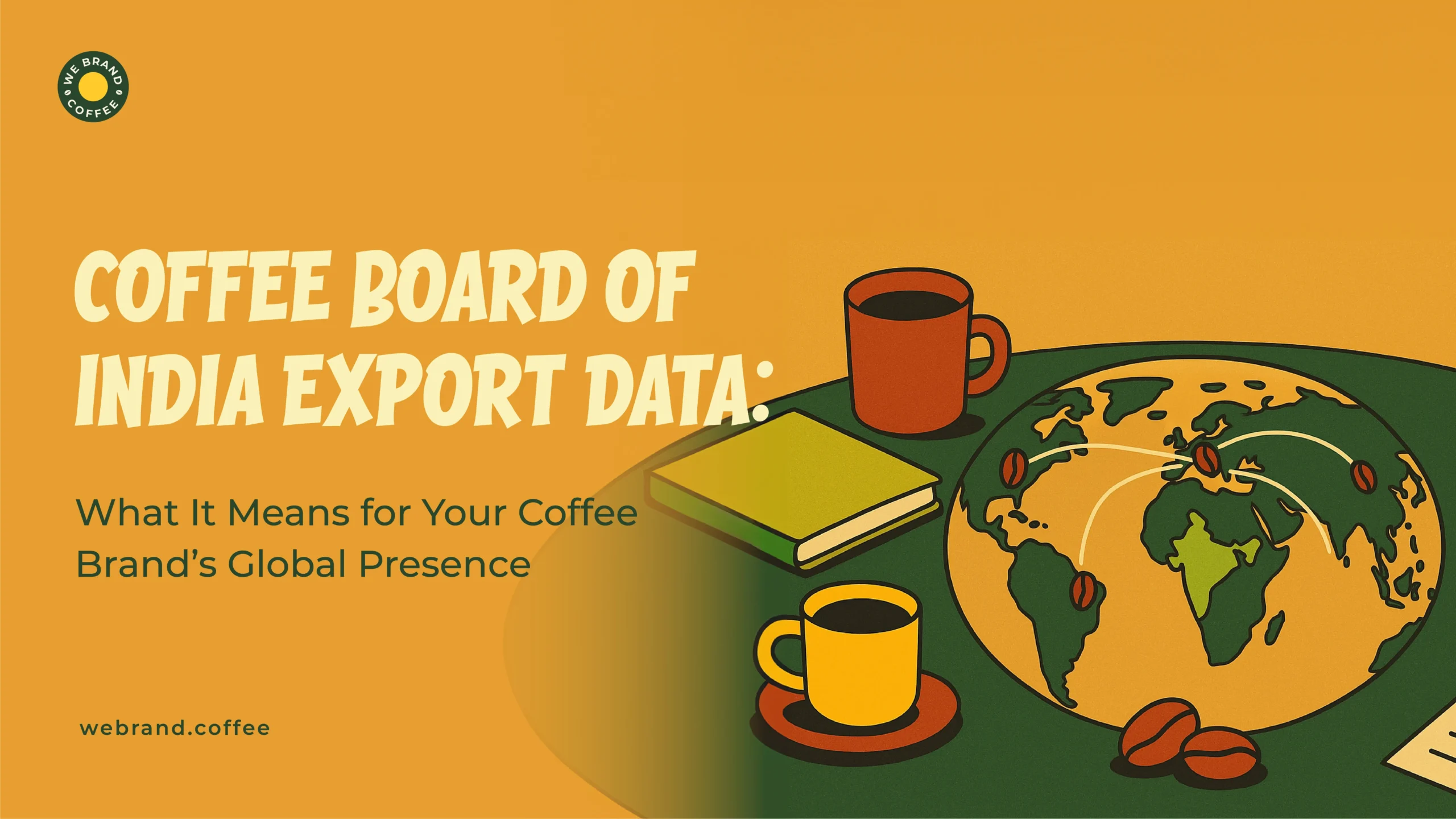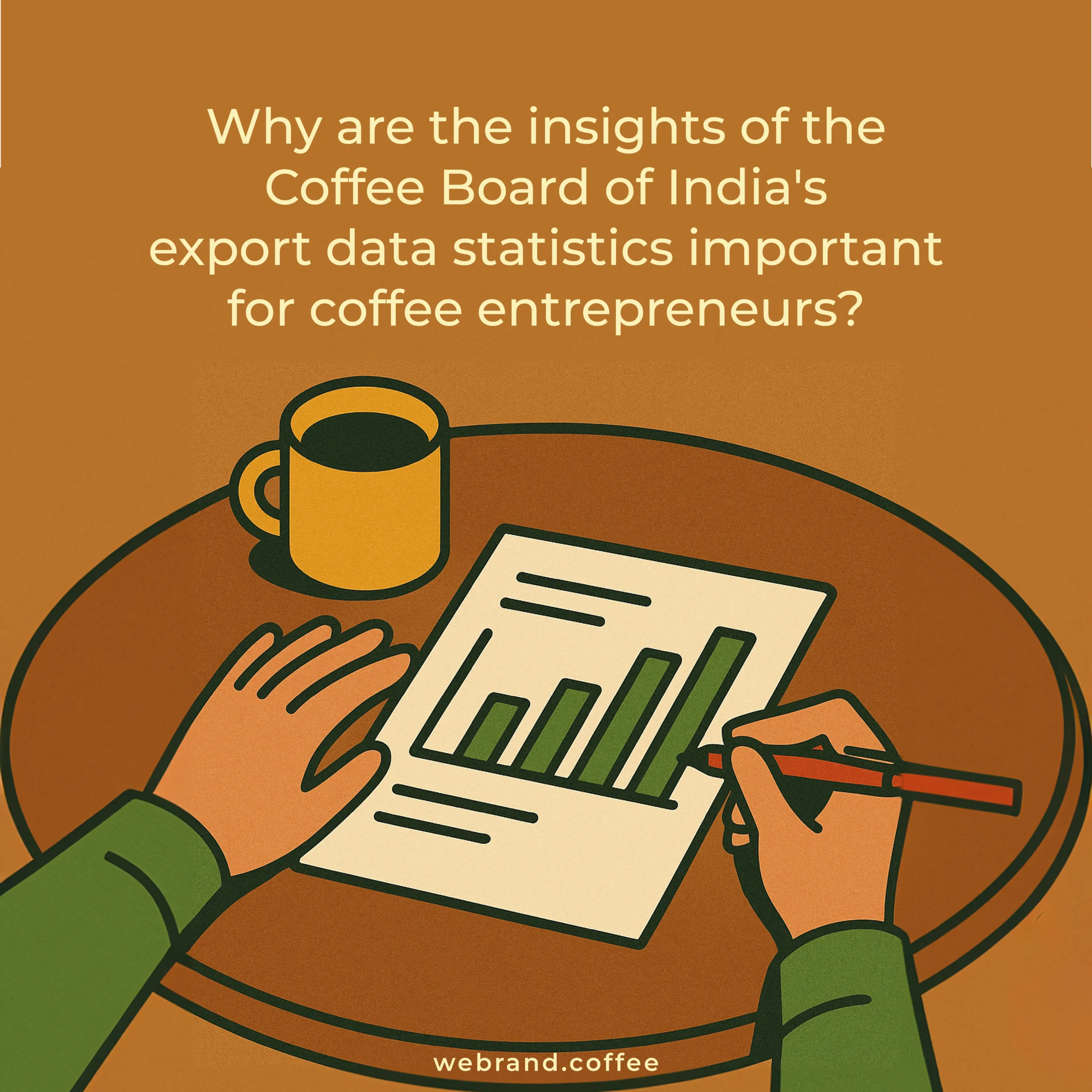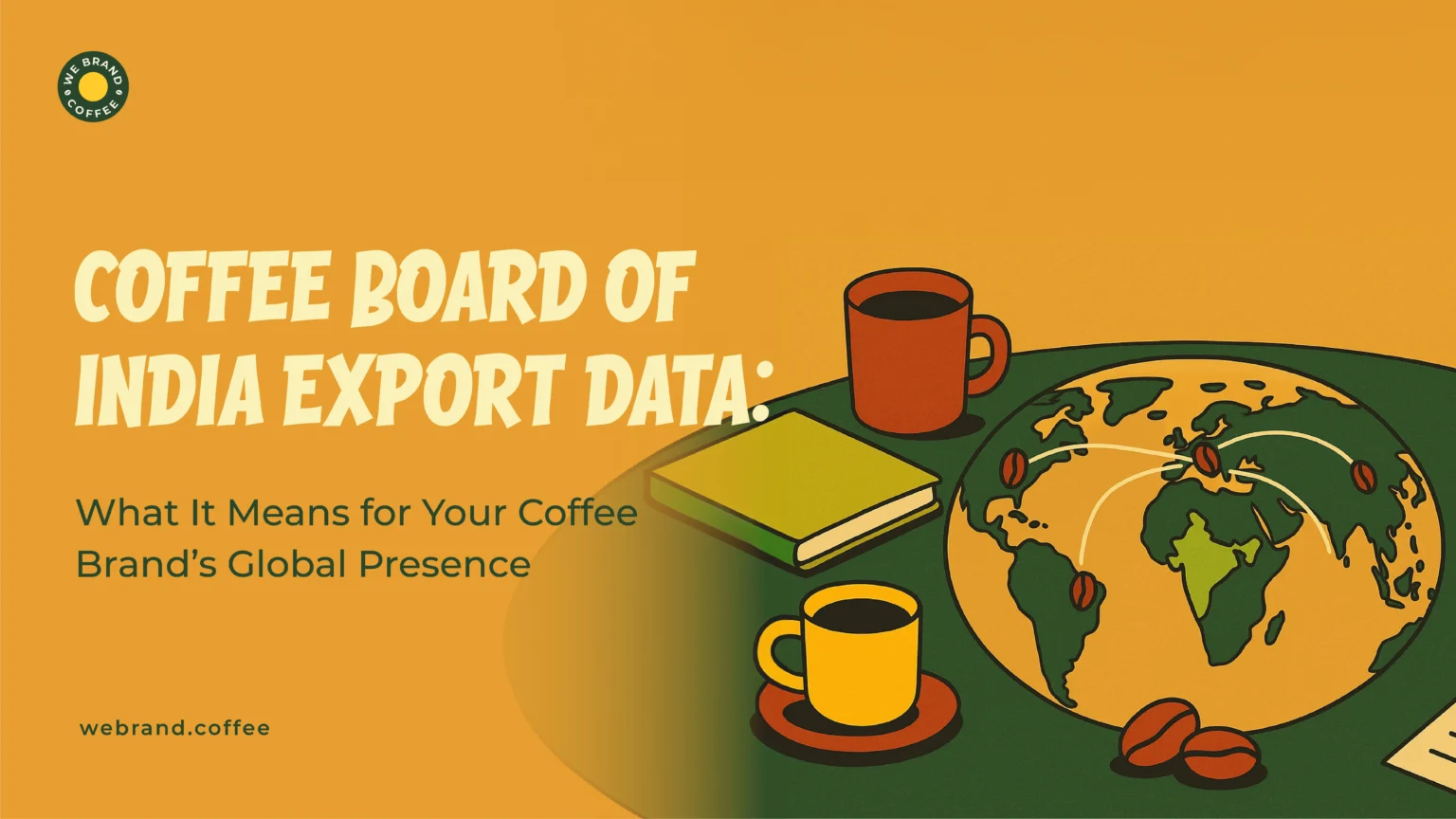Coffee Board of India Export Data: What It Means for Your Coffee Brand’s Global Presence

Recent Posts
Share this article:
If you are a coffee brand that is aiming to expand beyond the borders, then understanding the Coffee Board of India’s export data is essential, as it is more than just another list of statistics. The Coffee Board of India export data stands as a true reflection of how Indian coffee performs on the global stage. Be it the record of shipments, the indication of global demands, or consumer taste shifts, the Indian coffee export statistics help you as a brand in not only understanding the patterns of Indian coffee in the international coffee trade.
But why is it important? You see, once you decipher the hidden figures behind how Indian coffee is making its mark on the global stage, you, as an emerging exporter of coffee, have the opportunity not only to reach the current right audience but also to move with well-defined potential. What the Coffee Board of India export data carries with itself is not just mere numbers and charts, but rather it is a collective record of how far our Indian coffee has travelled and what the global market is craving in the future.
Having said that, what does the Coffee Board of India export data mean for your coffee brand’s global presence? You see, if you have a global ambition as a brand, then having an insight into the Coffee Board of India export data equips you with a major advantage for crafting your own international identity. It not only gives you an idea of which regions are rising and where Indian coffee fits into the map, but also allows you to make that decision of exactly what to offer to your overseas consumers as per their preferences.
In this blog, we aim to sit with the same not-so-glamorous-looking data, and understand what they reflect in reality and how the world sees Indian coffee. Based on the Coffee Board of India, we would also draw a brief on how these statistics affect your plan of exporting your beans and how you should move.
What are the key international markets for exporting India’s coffee?

Before we move on to analysing and dissecting the Coffee Board of India export data, if you are planning to enter the coffee export business, then the foremost important thing to have an insight into is the major international markets. It is needless to emphasise the popularity of the Indian coffee beans, as their export production is more than 70% today.
This means India as a nation exports over 400,000 metric tons of coffee in one financial year, which can be approximately valued at $1.8 billion.
Now coming back to the major international markets for exporting, it is safe to say that the European Union remains the primary as well as the largest market for exporting Indian coffee with accounting for over 60% of total coffee exports. Following the European market comes the other markets of Italy, with around 18% dominance, Germany with 11%, and Belgium at around 7% of the total export data.
Did you also notice how all the major export routes for Indian coffee lie geographically in and around Europe? Well, it is no secret that Eupore has always been fond of Indian Arabica and Robusta Cherry beans.
Be it the Italian espresso roasters blending Indian Robusta for its strong crema and body, or the Norwegian speciality roasters falling on Indian monsooned Malabar beans for bringing out that essence of sea wind scent.
But does that mean Indian coffee beans are limited to Europe only? No, the Coffee Board of India export data suggests that countries beyond Europe, such as Japan and South Korea, are also standing up as promising markets for Indian coffee beans. Now the reason can be their fascination with origin-based speciality coffee or the craving for deeper and earthier tones in their brew, but when it comes to the other sector of markets, for example, the Middle East, say the UAE, Saudi Arabia, or Jordan, the Indian coffee beans get a demand majorly due to the geographic proximity in comparison to other potential exporters of coffee around the world.
Having said that, the Coffee Board of India export data also suggest a small yet prominent market in the United States and Australia. Even though the business is in smaller volumes, the values lie as high as their desire for sourcing Indian Arabicas for single-origin labels.
While it is fascinating to know that this demand by speciality coffee brands in these regions has opened up an opportunity for Indian coffee to have its own distinct identity, similar to Latin American or African beans.
Moreover, these major coffee export markets for India are not only buying beans from ur, but they are shaping perception on how the world should perceive our beans, be it from the estates of Coorg or Chikamgaluru. Additionally, if we look into the Coffee Board of India export data, then we get to see that Indian coffee exports have very generously grown by around 125% in the past 11 years.
While this data might seem like a dream being fulfilled, with the value and reach of Indian coffee beans rising, it should be mentioned that the actual production has only grown marginally.
Even though India’s value-added coffee exports have seen an expansion in the above-mentioned markets, it should also be highlighted that India, as a coffee exporter, has been sold more for the quality, brand, and story rather than for the bulk sourcing of the beans.
Why are the insights of the Coffee Board of India’s export data statistics important for coffee entrepreneurs?

Now that we know where all our Indian coffee beans have the potential to travel, the next step is to straight up dive into the insights of the Coffee Board of India export data and look at it from the perspective of a coffee entrepreneur.
By going through the Coffee Board of India export data, we will not only get a real-time reflection of the global demand and consumer preference but also an idea of your brand opportunity to grow.
This insight into the Coffee Board of India export data allows you to recognise which regions are demanding more of your coffee beans and what flavour notes you should focus on to grow internationally.
For example, in the year 2023-24, India exported beans of around $1.8 billion, but we did not notice any growth in terms of production. What does this suggest? Well, this means that the value of per kilogram of beans is rising, which in turn is good news for Indian coffee growers as it pushes Indian coffee beans into a bracket of premium identity on a global stage.
Moreover, if you want to know how the world’s coffee is flowing, then stick to the data on how Italy and Germany together are buying around 30% of Indian coffee exports, but, on the contrary, major markets of Belgium, Russia, and the UAE are the countries you can focus on expanding to as these are quite fast cathing up export markets.
Another interesting aspect to look into is the green coffee export space, as India has been exporting for over 4 lakh tonnes of coffee to around 70 countries. Hence, if you are planning to get into that space, then be ready to cater in terms of bulk with consistency.
Similarly, if you are a speciality roster, then looking into the value-added exports where you can build your story and brand differentiation might be a strategic move to make.
However, if you are aiming to build a new coffee label, then focusing on the export trends given by the Coffee Board of India export trade data, as it allows you to understand what flavour profiles you can go ahead with on a global level.
As an entrepreneur, you need to take into consideration each of these insights, as it allows you to blend your ideas with the potentially risky ones.
Apart from that, here is what you should look into, particularly from the Coffee Board of India export data that will help shape the direction of your business:
- Identify the lucrative global markets
The foremost data to analyse from the export data is where the Indian coffee is most demanded. Based on that, you can move forward with pinpointing your export market and matching your beans as per the regional preferences.

- Understand the price trends and demand shift.
Another benefit you get by analysing the Coffee Board of India export data is that you get to have an overview of the price trends depending on the demand shifts. For instance, the Coffee Board’s statistics allow you to track your export values, unit prices, and year-on-year changes. Having an insight into the same allows you to not only anticipate the highs and lows of the market but also plan your coffee harvesting cycles more strategically, along with staying competitive in the international market with your prices.

- Identify the upcoming trends and niche
When you have an in-depth understanding of the Coffee Board of India export data, it gets easy for you to get an overview of where to invest your micro-lot production. You know all those question that comes to you like, like whether there will be a rise in speciality Arabica exports or not? You can expect an increased demand for either instant or freeze-dried coffee exports? At what time should you consider value-added processing?
The answer to these complicated yet crucial questions becomes quite easy when you start reading between the lines of the Coffee Board of India export data, as it not only guides you towards a future of coffee export that aligns with the future demand but also gets your export model and ideas out of the past.

- Strengthen the investor and trade partnership.
One quite underrated yet most beneficial part of getting to know the insights of the Coffee Board of India export data is the fact that this data builds a sense of credibility within you to back your pitches with expert data of the India coffee export statistics. Be it the growth rates, export destinations, or production patterns, when you speak the language of the investors, it allows you to build that trust within them and gives you an opportunity to build your own brand story and take it to the actual potential that it deserves.
- Make policy-aligned business decisions.s
Getting yourself known with the intricacies of the Coffee Board of India export data also brings you an opportunity to build your export plans as per the latest trade policies, subsidies, or sustainability programs, which saves you from any error and to and fro of applications. Hence, the Coffee Board of India export data allows you to get into government-backed promotion schemes and save yourself some time and effort.
In addition to these, why are such insights into official data important? Because you get to actually move ahead in your journey from intuition to a more planned and informed strategy that is backed by well-researched data, which in turn ultimately gives you a position to be a serious contender in the international coffee market.

How is your packaging important for competing on a global basis?
Major coffee export routes? Check. The statistical data to consider? Check. What about your product packaging? Does that also play a role when you are exporting? Well, yes. When you are travelling with your product, the very first thing that it communicates with is the packaging of your product.
The international coffee market in itself is a very crowded one, with multiple brands being more prominent than others. In between these, it becomes very important for you to differentiate yourself and present your bean story in the most impactful manner possible.
But how does it impact your global stance? Here is an overview of the importance of strategic product packaging when it comes to expanding on a global basis:
- When you are presenting your beans internationally, the consumer is less likely to know your brand story; hence, a well-designed package builds a perception of quality, credibility, and care.
- What is underrated is that through a well-strategised packaging, you can cater to the specific culture you are planning to export to. For instance, in Japan, a more minimal and calm packaging would connect more, whereas in Europe, a sustainable approach and authentic reflection would sell the best. So, when it comes to exporting, packaging plays an equal role in making your beans connect well with the local consumers of that region.
- Having a thoughtful package also gives your brand an image of professionalism and is ready for all launches in all sectors. Be it the aligned barcodes, freshness values, nutritional contents and other labelling, having it all aligned gives a sense that you, as a brand, deliver consistently and that you are also serious about what you are doing.
- The looks, the connect, the professionalism, to be very honest, they are all secondary parts of the packaging importance. What we always push to the last when it comes to packaging is the functionality of it. Well-designed packaging complies not only with the temperature shifts, humidity, and the time zones protecting your beans, but also keeps your beans fresh with the help of advanced packaging of vacuum sealing, nitrogen flushing, and multi-layered laminates and saves your fresh roast from losing its charm.
Apart from this, if we delve more into the importance of packaging o,r more s,o the interdependence of packaging with export, then many more factors come into play. These can be the sustainability factor, or the differentiator factor, which translates your values, vision, and mission as a brand exporting the finest beans to the major coffee consumer markets of the world.
Can WeBrandCoffee help you, as an Indian coffee brand, go global?
Now that you know the importance of packaging when it comes to exporting coffee on a global stage, the very next question that would come to you isHoww do you design something that will stand as a differentiator on a global level in something as popular as coffee?
You see, the truth is that all coffee packaging requires some guideline factors to be qualified for securing the freshness of your roasts, and these elements of design remain consistent through all good packages.
However, the differentiator comes into play when you successfully translate your own story of beans and brand through that packaging. This is because, amongst everything, the only true and unique factor is your brand story. And if it is unique, it has the potential of being a differentiator.
Now coming to us, WeBrandCoffee has been in branding coffee brands for quite some time now,w so be it about finding your global voice, presence, or purpose, our team is truly excellent in finding your knack and exporting a brand overseas that truly resonates across multiple cultures.
How? Here’s how”
- We decode the global coffee market for you
- We build a brand that speaks a global language
- We design packaging that translates to the global consumer
- We help you build a digital identity that scales
- We guide you through the export-branding journey
So, to answer your question, yes. WeBrandCoffee can help you build that ultimate global presence through a combination of market insights, creative strategy, as well as design intelligence and obviously all backed and aligned by what the Coffee Board of India export data suggests.
Frequently Asked Questions:
How much coffee does India export?
India exports somewhere around 70 to 80 % of its total coffee production each year. This makes the country one of the top 10 coffee exporters in the world. As per the 202 CoffeeBoard of India export data, India exported over 400,00tonses of coffee valued at around 1billion USD.
Which countries import Indian coffee?
India exports coffee mainly to European countries, including Italy, Germany, Russia, Poland, Belgium, Spain, alongside the USA, Japan, as well as South Korea.
How does branding impact coffee exports?
A well-branded coffee, when exported, has more opportunity to look credible and carry a unique story of origin, which indirectly allows you to expand more and connect with the global consumer more.
Conclusion
In conclusion, the Coffee Board of India export data stands as an ultimate playbook of what you can do and in what direction you can move with your brands and dreams of exporting across the globe.
The major learning you can take from these well-curated export data is not about what has been done, but to plan your own what can be done strategically to take your business on a global level.






